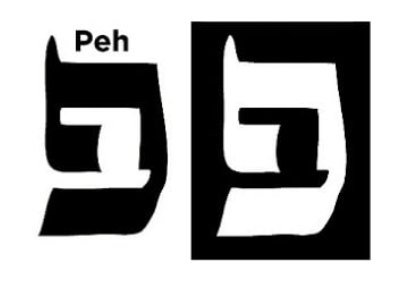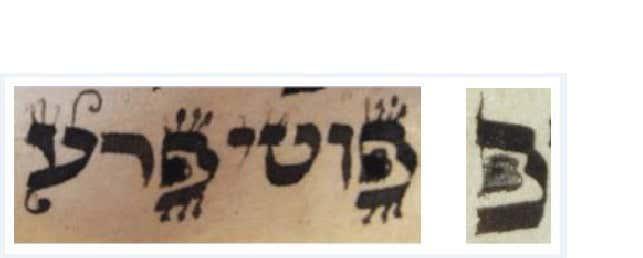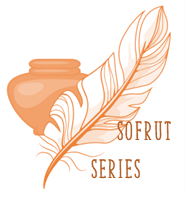

... כְּפוּפָהקל – קַבָּלָה מֵהֶחָסִיד לַעֲשׂוֹת לָהּ זָוִיּוֹת לְכַתְּחִלָּה לְמַעְלָה בְּצַד יָמִין מִבִּפְנִים וּמִבַּחוּץ. אֲבָל לְמַטָּה תִּהְיֶה עֲגֻלָּה מִבַּחוּץ, כְּמוֹ כָּל הַכְּפוּפוֹת שֶׁצָּרִיךְ לִהְיוֹת עֲגֻלּוֹת לְמַטָּהקלא לְכַתְּחִלָּה. אֲבָל מִבִּפְנִים שָׁם תְּהֵא לָהּ זָוִיּוֹת, כְּדֵי שֶׁיְּהֵא בַּלָּבָן שֶׁבִּפְנִים צוּרַת בֵּי"ת, כִּי כֵּן קַבָּלָה מֵהֶחָסִיד.קלב
פְּשׁוּטָה – צְרִיכָה לִהְיוֹת עֲגֻלָּה לְמַעְלָהקלג בְּצַד יָמִין לְכַתְּחִלָּה, כְּמוֹ שֶׁהַכְּפוּפָה הִיא לְמַטָּה.קלד אֲבָל קַבָּלַת הֶחָסִידקלה לַעֲשׂוֹתָהּ מְרֻבַּעַת לְמַעְלָה, כְּמוֹ שֶׁהַכְּפוּפָה הִיא לְמַעְלָה. וּצְרִיכָה לִהְיוֹת אֲרֻכָּה לְכַתְּחִלָּה כְּשִׁעוּר שֶׁתִּהְיֶה רְאוּיָה לְהֵעָשׂוֹת פֵּ"א כְּפוּפָה אִם תִּכְפְּפֶנָּה.קלו....
... According to a tradition received from [R. Yehudah] the Chassid, the initial preference is that the upper right corner of the curved pei be angular, both inside and outside. Its lower [right corner], by contrast, should be rounded on the outside, just as all the curved letters should preferably be rounded at the lower [right corner]. However, the inner edge [of the lower right corner] should be angular, so that the white space within the letter will resemble a beis, for this is a tradition received from [R. Yehudah] the Chassid. [See fig. 15]
By initial preference, the [final] pei should be rounded at its upper right [corner], just as the curved pei is [rounded] at its lower [right corner]. Nevertheless, it is a tradition received from [R. Yehudah] the Chassid that [its upper right corner] should be angular, like the curved [pei]. [The letter] should preferably be long enough so that if [its leg] were to be bent [to the left], a curved pei would be formed....2
(ב) ... פ' כפופה קבלח מהחסיד לעשות לה זויות לכתחל' למעלה בצד ימין מבפנים ומבחוץ. אבל למטה תהי' עגולה מבחוץ כמו כל הכפופות שצריכות להיות עגולות למטה לכתחלה. אבל מבפנים שם תהא לה זויות כדי שיהא בלבן שבפנים צורת ב' כי כן קבלה מהחסיד. ויעשה לה עוקץ על פני' לצד שמאל. ועוקץ זה ירד למטה אל הנקודה שבתוכה. שהנקודה ומשך העוקץ יהי' כתמונת וי"ו ולכן תהי' הנקודה למטה לצד שמאל עגולה (ב"י בשם ב"ש) ויזהר שלא תיגע הנקודה אפי' בעוקץ דק בשום מקום חוץ מן העוקץ שהיא תלויה בו:
ף' פשוטה צריכה להיות עגולה למעלה לצד ימין לכתחלה כמו שהכפופה היא למטה. אבל קבלת החסיד לעשותה מרובעת למעלה כמו שהכפופה היא למעלה. וצ"ל ארוכה לכתחלה כשיעור שתהא ראויה להעשות פ"א כפופה אם תכפפנה. ויזהר בנקודה שבתוכה שלא תהי' הפוכ' לצד חוץ פן תדמה לתי"ו (ב"י בשם הראי"ס): ....
... Peh, bent: According to the Chasid, its upper right corner should be squared both inside and out, but below it should be rounded on the outside like all the bent letters, which lekhatchilah are rounded below. However, inside it should be squared, so that the white space inside will have the form of a beis; this is the kabbalah of the Chasid. One should make a point on its face on the left-hand side; this point extends downwards to the dot inside, so that the dot and the extended point have the form of vav, and accordingly the dot should be rounded on its lower left side. One must take care that the dot does not touch, even by the smallest amount, anything except the point from which it hangs.
Peh, straight: Lekhatchilah it should be rounded on its upper right side, just as the bent form is below. But the Chasid says one should make it squared at the top like the bent form is at the top. Lekhatchilah one should make it long enough that were it bent round it would have the form of bent peh. One must take care that the dot not turn outwards, lest it resemble tav (Beis Yosef in the name of the Rosh)....3
The shift to the Ketiva Tamah form of the peh, which is the modern standard, began in 1858 and was nearly universal by about 1890. The Chofetz Chaim was successful in eradicating the use of the peh-shavur by the early 1930s, but there continued to be soferim employing the Older Beis Yosef peh, particularly in the Chabad tradition.
(סד) צורת אות פ"א כפופה
(סה) אות פ"א כפופה צריך להיות לה לכתחלה למעלה בצד ימין זוית מבפנים וגם מבחוץ יהיה כזוית קטן. ותהיה משוכה קצת לאחוריה שתהיה עגולה מבחוץ וכן למטה תהיה עגולה מבחוץ וכמו כל הכפופות שצריך להיות עגולה למטה לכתחלה אבל מבפנים יהיה לה זוית כדי שיהיה בלובן שבפנים צורת בי"ת ותהיה רחבה קולמוס וחצי כדי לתלות בה הנקודה שבפנים שלא תגע בהאות גופה [הג"ה ולא כמה שנהגו איזה סופרים לעשות עקב מבחוץ בצדה כזה ואומרים שזה להטיב הבי"ת לבן מבפנים כי הוא ממש אות שבור. ובאמת צריך להיות עגול מבחוץ כמו שכתבנו ורק בפנים צריך להיות בי"ת לבן ומה שנהגו כך מפני שאינם יודעים ההרגל לעשות לתפוס הקולמוס באלכסון ולהמשיכה מעט לאחוריה הקולמוס בפנים שעי"ז נעשה לה זוית בפנים כמבואר בב"י ע"כ יצא להם הטעות לעשות עקב מבחוץ גם במה שנהגו לכתוב משוכה מסוף גגה מעט והנקודה עושים בזוית ולא עגולה הם מקלקלים הוא"ו לגמרי עכ"ל ספר כתיבה תמה בקיצור לענינינו. ובאמת מי שאינו יודע לעשות כמש"כ הכתיבה תמה יותר טוב לעשות בי"ת מבפנים בלא עקב רק בזוית לבד ממה שיעשה פ"א שבור מבחוץ כי אפילו בתמונת הבי"ת גופא העקב לא לעיכובא הוא כלל וכ"ש בזה שלא נזכר עקב כלל בב"ש בודאי לא נכון הוא לעשות עי"ז הפ"א שבור ע"כ הג"ה] ויהיה לה עוקץ על פניה לצד שמאל ויורד למטה אל הנקודה שבתוכה ותהיה הנקודה תלויה בה כי הנקודה ומשך עוקצה יהיה בתמונת וא"ו כשיהפוך הפ"א. ומה"ט תהיה הנקודה למטה לצד שמאל עגולה כתמונת ראש הוא"ו. ולא תגע הנקודה בשום מקום מבפנים ואם נגעה פסולה. גם יזהר בהנקודה שלא תהיה הפוכה לצד חוץ דאל"ה צ"ע אפילו דיעבד. ואם לא תלה הנקודה בהעוקץ שעל פני הפ"א והרחיקה מקצה הגג לבפנים יש להסתפק בו ודינו כמו בה' שתלה רגל שמאלו באמצע הגג וכנ"ל באות ה"א. ואם לא נגעה הנקודה בגגה ותינוק קראה פ"א יש לתקן ותיקון מועיל אפילו בתו"מ וכנ"ל בסי' ל"ב סכ"ה עיי"ש. ואם לא עשה הנקודה רק קו שוה עיין לעיל סוף אות אל"ף:
(סו) צורת אות פ"א פשוטה
(סז) אות פ"א פשוטה צריך לעשותה לכתחלה בזוית למעלה כמו שהכפופה היא למעלה. גם צריכה להיות ארוכה לכתחלה כשיעור שתהא ראויה לעשות פ"א כפופה אם תכפפנה ובדיעבד אם יש ברגל ימיני מכנגד מקום הנקודה ולמטה כמלא יו"ד די בכך [הפמ"ג כתב סתם כמלא יו"ד מהירך והכוונה כאשר כתבנו דאל"ה אין צורת אות עליו] ומ"מ אם נמצא כן בס"ת ואפילו בתפילין לכתחלה בודאי חייב לתקן האות ולהשלימו כדין ואין בזה משום שלא כסדרן כיון דבלא התיקון הוא כשר. ועשיית נקודת הפ"א ועוקצה הוא הכל כמו בכפופה. גם יזהר שלא תהיה הנקודה הפוכה לצד חוץ כדי שלא תדמה לתי"ו. אם לא נגעה הנקודה בגג או שהרחיק הנקודה מקצה הגג לבפנים הכל דינו כנ"ל בכפופה:

(ח) וְיִזָּהֵר בָּאוֹתִיּוֹת הַגְּדוֹלוֹת וּבָאוֹתִיּוֹת הַקְּטַנּוֹת וּבָאוֹתִיּוֹת הַנְּקֻדּוֹת וְאוֹתִיּוֹת הַמְשֻׁנּוֹת כְּגוֹן הַפֵּאִי״ן הַלְּפוּפוֹת וְהָאוֹתִיּוֹת הָעֲקֻמּוֹת כְּמוֹ שֶׁהֶעְתִּיקוּ הַסּוֹפְרִים אִישׁ מִפִּי אִישׁ. וְיִזָּהֵר בַּתָּגִין וּבְמִנְיָנָן. יֵשׁ אוֹת שֶׁיֵּשׁ עָלֶיהָ תָּג אֶחָד וְיֵשׁ אוֹת שֶׁיֵּשׁ עָלֶיהָ שִׁבְעָה. וְכָל הַתָּגִין כְּצוּרַת זַיִנִּי״ן הֵן דַּקִּין כְּחוּט הַשַּׂעֲרָה:
(8) He should pay careful attention to the letters that are written large or small, to the letters that are punctuated with dots above them, to the letters that are written differently to the others, such as the letter Pé and the letters that are curved, in the way the scribes have carried on the tradition. He is to pay attention to the tittles and the number of them in each case—one letter having above it a single tittle, another having seven tittles. All the tittles have the shape of the letter Zain and are to be thin as a hair.
(ד) יש עוד דברים שנהגו בהם הסופרים כמו שהעתיקו איש מפי איש כמו באותיות הגדולות והקטנות והנקודות והמשונות. וכל אלו למצוה ואם שינה לא פסל. ויזהר בנקודות שלא תהא בהן צורת יו"ד או אחד משאר גלמי אותיות (תשו' הרמ"ע סי' ל"ח):
There are various traditions which are passed from scribe to scribe concerning the large and small letters, and the dots, and the altered letters. Ideally one does these, but their omission does not invalidate. One should take care that the dots do not resemble yods or any other letter forms (responsa of R’ Menachem Azariyah, #38).4

Older Yemenite Sifrei Torah have 154 instances of the peh lefufah (as compared against the 194 called for in Sefer Tagin).5
(א) שבע כפולות בג"ד כפר"ת (מתנהגות בשתי לשונות), יסודן חיים ושלום וחכמה ועושר חן וזרע וממשלה, ומתנהגות בשתי לשונות ב"בּ ג"גּ ד"דּ כ"כּ פ"פּ ר"רּ ת"תּ תבנית רך וקשה תבנית גבור וחלש כפולות שהן תמורות. תמורת חיים מות תמורת שלום רע תמורת חכמה אולת תמורת עושר עוני תמורת חן כיעור תמורת זרע שממה תמורת ממשלה עבדות:
(ב) שבע כפולות בג"ד כפר"ת שבע ולא שש שבע ולא שמונה בחון בהן וחקור מהן (וצור וחשוב) והעמד דבר על בוריו והשב יוצר על מכונו:
(ג) שבע כפולות בג"ד כפר"ת כנגד ז' קצוות מהם ו' קצוות מעלה ומטה מזרח ומערב צפון ודרום והיכל הקדש מכוון באמצע והוא נושא את כולן:
(1) There were formed seven 'double' letters: Bet [b/v], Gimel [g/j], Dalet [d/dh], Kaph [k/kh], Pe [p/ph], Resh [r/rr], Tav [t/th], each has two voices, either aspirated or softened. These are the foundations of Life, Peace, Riches, Beauty or Reputation, Wisdom, Fruitfulness, and Power. These are double, because their opposites take part in life, opposed to Life is Death; to Peace, War; to Riches, Poverty; to Beauty or Reputation, Deformity or Disrepute; to Wisdom, Ignorance; to Fruitfulness, Sterility; to Power, Slavery.
(2) These seven double letters point out the dimensions, East, West, height, depth, North, South, with the Holy Temple in the middle, sustaining all things.
(3) These seven double letters He formed, designed, created, and combined into the Stars of the Universe, the days of the week, the orifices of perception in man; and from them he made seven heavens, and seven planets, all from nothingness, and, moreover, he has preferred and blessed the sacred heptad.
(ט) המליך אות פ' וקשר לו כתר וצר בו נוגה בעולם ויום ה' בשנה ונחיר ימין בנפש:
(9) Pe, predominant in power, crowned, combined, and formed Venus in the Universe, the fifth day of the week, and the right nostril in man.
(א) שבע כפולות בג"ד כפר"ת מתנהגות בשתי לשונות ב"ב, ג"ג, ד"ד, כ"כ, פ"פ, ר"ר, ת"ת. תבנית רך וקשה גבור וחלש:
(ב) שבע כפולות בנ"ד כפר"ת יסודן חכמה עושר זרע חיים ממשלה שלום וחן:
(ג) שבע כפולות בג"ד כפר"ת בדבור ובתמורה תמורת חכמה אולת תמורת עושר עוני תמורת זרע שממה תמורת חיים מות תמורת ממשלה עבדות תמורת שלום מלחמה תמורת חן כיעור:
(ד) שבע כפולות בג"ד כפר"ת מעלה ומטה מזרח ומערב צפון ודרום והיכל הקודש מכוון באמצע והוא נושא את כולם:
(ה) שבע כפולות בג"ד כפר"ת שבע ולא שש שבע ולא שמונה בחון בהם וחקור בהם והעמד דבר על בוריו והשב יוצר על מכונו:
(ו) שבע כפולות בג"ד כפר"ת יסוד חקקן חצבן צרפן שקלן והמירן וצר בהם שבעה כוכבים בעולם שבעה ימים בשנה שבעה שערים בנפש זכר ונקבה:
(1) Seven Doubles:/ Bet (ב), Gimel (ג), Dalet (ד),/ Kaf (כ), Peh (פ), Resh (ר), Tav (ת)./ They direct themselves with two tongues/ Bet-Bhet, Gimel-Ghimel, Dalet-Dhalet,/ Kaf-Khaf, Peh-Pheh, Resh-Rhesh, Tav-Thav,/ A structure of soft and hard,/ strong and weak
(2) Seven Doubles: BGD KPRT (בגד כפרת)/ Their foundation is/ Wisdom, Wealth, Seed,/ Life, Dominance, Peace and Grace.
(3) Seven Doubles: BGD KPRT (בגד כפרת)/ in speech and in transposition./ The transpose of Wisdom is Folly/ The transpose of Wealth is Poverty/ The transpose of Seed is Desolation/ The transpose of Life is Death/ The transpose of Dominance is Subjugation/ The transpose of Peace is War/ The transpose of Grace is Ugliness
(4) Seven Doubles: BGD KPRT (בגד כפרת)/ Up and down/ East and west/ North and south/ And the Holy Palace precisely in the center/ and it supports them all.
(5) Seven Doubles: BGD KPRT (בגד כפרת)/ Seven and not six/ Seven and not eight/ Examine with them/ And probe with them/ Make [each] thing stand on its essence/ And make the Creator sit on His base.
(6) Seven Doubles: BGD KPRT (בגד כפרת) of Foundation/ He engraved them, He carved them,/ He permuted them, He weighed them,/ He transformed them,/ And with them He formed,/ Seven planets in the Universe,/ Seven days in the Year,/ Seven gates in the Soul,/ male and female.
(טו) שבע כפולות בג"ד כפר"ת שבהן נחקקין שבעה עולמות, שבעה רקיעין, שבע ארצות, שבעה יַמים, שבעה נהרות, שבעה מדברות, שבעה יָמים, שבעה שבועות, שבע שנים, שבע שמיטין, שבעה יובלות, והיכל הקדש, לפיכך חבב את השביעיות תחת כל השמים:
(15) Seven Doubles: BGD KPRT (בגד כפרת)/ With them were engraved/ Seven Universes, seven firmaments,/ seven lands, seven seas,/ seven rivers, seven deserts,/ seven days, seven weeks,/ seven years, seven sabbaticals,/ seven jubilees./ and the Holy Palace./ Therefore, He made seven beloved/ under all the heavens.
- Variant Interpretations on the Form of Chet
- The Arm of the Tsade: Outstretched vs. Introspective
- Qoph: The Embellishment of the Head
- Shapeshifting Shin/Sin in Sofrut STA''M
- The Baal Shem Tov, Rabbi Israel ben Eliezer (1698-1760), is credited with the founding of the Chasidic Movement.
- The Hebrew text and English translation for this portion are from https://www.chabad.org/library/article_cdo/aid/3284482/jewish/Shulchan-Aruch-Chapter-36-Laws-Relating-to-Precise-Shape-of-Scribal-Letters.htm.
- Translation from Brian Tice, K'tav Tam Teimani: A Compendium of Classic Sources on Jewish Scribal Rules (publication pending).
- Translation from Brian Tice, K'sav Tam Ashkenaz: A Compendium of Classic Sources on Jewish Scribal Rules (publication pending).
- Brian Tice, Sefer Tagin: An Ancient Sofer Manual (Grand Rapids, Mich.: Yiddishkeit 101, 2021), 76-85,




